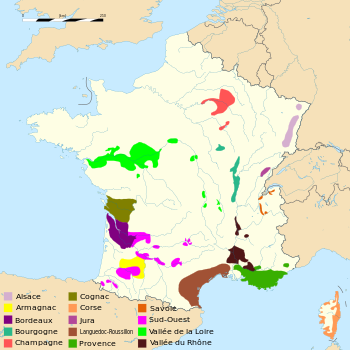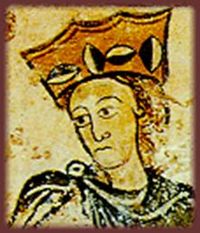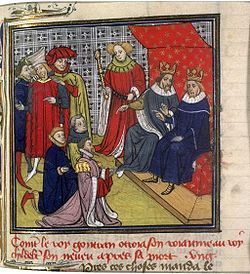History of French wine

The history of
Over the course of its history, the French wine industry would be influenced and driven by the commercial interests of the lucrative English market and Dutch traders. Prior to the
Early history
There is archaeological evidence to suggest that the

The early Greek settlers brought a distinctly Mediterranean outlook to viticulture in Gaul. To their understanding, vines grew best in the same climate and area that would support
It was also during the late first century BC/early first century AD that viticulture started to spread to other areas of Gaul — beyond areas where the olive and fig would grow, where a suitable variety was found to be the biturica, the ancestor of
Expansion continued into the third century AD, pushing the borders of viticulture beyond the areas of the holm oak to places such as Bordeaux in
The
Middle Ages through the Age of Enlightenment

During the
In the

The 1305 election of
The 14th century was a period of peak prosperity for the Bordeaux-English wine trade that came to a close during the
The
Revolution to Phylloxera

Following the French Revolution there was an increase in the amount of poor quality French wine being produced. Jean-Antoine Chaptal, the Minister of the Interior for Napoleon, felt that a contributing factor to this trend was the lack of knowledge among many French vignerons of the emerging technologies and winemaking practices that could improve the quality their wines. In 1801, Chaptal compiled this knowledge into a treatise Traité théorique et pratique sur la culture de la vigne which included his advocacy of adding sugar to the wine to increase alcohol levels—a process now known as chaptalization. Chaptal's treatise was a turning point in the history of wine technology as it synthesized the knowledge current to the beginning of the 19th century.[11]
By the mid 19th century, the wine industry of France enjoyed a golden period of prosperity. A new class of consumers, the

A series of events brought this golden age of prosperity to an end. In the 19th century, scientific interest in collecting

But just as French vignerons were recovering from oidium came a new mysterious ailment that caused decay or death in the grapevines. The cause was a tiny louse, known as phylloxera, imported from North America. This louse targets the rootstock of the vine. The solution to this epidemic also came from North America in the grafting of naturally resistant American rootstocks to the European vines. However, while the importing of this new North American plant material helped to stave off the phylloxera epidemic, it brought with it yet more problems-the fungal disease of downy mildew that first surfaced in 1878 and black rot that followed in the 1880s.[1]
The devastation to French vineyards brought with it the opportunity to explore new plantings and many vignerons began to experiment with
To the modern day
In the late 19th century the French government commissioned
Pasteur identified several causes of wine spoilage including some that could be controlled during winemaking. He noted that "

The
The 20th century brought two
Influences on the French wine industry
Throughout its history, the French wine industry has been shaped by the influences of both external and internal forces. Three of the more prominent and pervasive influences came from the English/British people through both commercial interest and political factors, the Dutch who were significant players in the wine trade for much of the 16 and 17th century and the Catholic Church which held considerable vineyard properties until the French Revolution.
The British

Over several centuries, a number of factors contributed to the prominent influence that Great Britain has had over the French wine industry. With a cool wet climate, the
Following the
The Dutch
In the 16th and 17th century, the Dutch (particularly those from

Dutch interest in the wine trade prompted advancement in winemaking styles and technology. One problem that plagued the French wine trade was the perishability of wine which rarely survived longer than the next vintage. French wine during this period was often unbalanced and unstable, being not properly clarified during wine making and lacking the alcohol needed to preserve the wine.[16] This was of concern to the Dutch who would sometimes be delayed in their trading with ports along the Baltic and White Seas when they became impassable in the winter. To ward off spoilage the Dutch developed methods of fortification by adding brandy to the wine to stop fermentation and increase the life expectancy of the wine. The Dutch further introduced to the French a method of sulfuring the wines (known as allumettes hollandaises) which has the effect of stabilizing the wine and preventing some degree of spoilage.[15] The introduction of new Dutch winemaking techniques helped antiquated methods such as the use of lead fall into disuse. Used since the days of Ancient Rome, lead was used in regions such as Poitou to help sweeten and preserve some of their wines leading to various ailments that collectively were known as the "Poitou colic". By the end of the 17th century, most Poitou winemakers had stopped using lead in their wine production.[16]
The Dutch also promoted the plantings of many white wine varieties that were in fashion through Europe. In regions like
The Christian Church

While there have been theories put forth that the Christian Church "saved" viticulture in France following the fall of the Roman Empire, the Germanic tribes that invaded the region were known to be fond of wine themselves leaving little evidence that viticulture and winemaking needed to be "saved" during this period. The Church, however, did become one of the most prominent and influential forces in French winemaking during the medieval period due to their vast holdings of vineyard lands.
The reign of Charlemagne brought in a period of peace, stability and prosperity that helped foster the growth of the emerging wine regions of France. In 775 he gave the abbey of Saulieu a plot of land that bears his name today in the grand cru vineyard of Corton-Charlemagne. The spread of viticulture during Charlemagne's reign was fueled in part by the expansion of the Christian Church which needed a daily supply of wine for the sacrament of the Eucharist, the monks' personal consumption as well as for hospitality extended to guests. Important guests visiting the monasteries would be more likely to support the Church generously if they were entertained well during their stay. The extent of their holdings of vineyards and the quality of wine they produced became a status symbol for the bishops, putting them on par with the nobility. Some bishoprics even moved to be closer to their vineyard holdings, such as the bishopric of Saint-Quentin which moved to Noyon near Paris and the bishopric of Langres which moved to Dijon just north of the Côte-d'Or in Burgundy. The influence of Christianity helped to create two categories of wine in Medieval France-simple, basic wine meant for daily consumption and more superior, premium wine that was reserved for impressing important guests.[18]
Various monastic orders became synonymous with certain wine regions due to their ownership of what is today considered some of most prized vineyards lands. The first group of monks to acquire vineyards on a large scale were the

One of the most famous holdings of the
Through their extensive holdings, the monasteries of the Christian Church made many advances in French winemaking and viticulture with the study and observation of key vineyards sites, identifying the grape varieties that grew best in certain regions and discovering new methods of production.[17] In 1531 it was a monk in the Languedoc region of Limoux that discovered the process of turning still wine into sparkling wine.[7] Though the widespread tale of Dom Pérignon "inventing" the sparkling wine known as Champagne is inaccurate, the Benedictine monk nonetheless made several important contributions to the history of French wine. In 1668, Brother Pierre Perignon was appointed treasurer of the abbey of Hautvillers, located north of Épernay with his role including management of the abbey's vineyard holdings and the collection of tithes from the community in the form of grapes and wines. Dom Perignon took the wine from all these sources and blended them to produce a wine that fetched far higher prices than wines from other parts of Champagne. Perignon's practice of blending from several different vineyards was unique and largely unheard of till then. He also pioneered the practice of severe pruning in the vineyard to keep yields low.[20]
See also
References
- ^ a b c d e f g h i j k l m n o p Robinson, pp. 281–83.
- ISBN 0-671-68702-6
- ^ Strabo, Geography 4.2.1.
- ^ a b Encyclopaedia Romana: Wine and Rome.
- ^ ""Documentary Amphorae", Athena Review 1.4". Archived from the original on 2018-01-29. Retrieved 2008-07-19.
- ^ Metropolitan Museum of Art, acc. no. 47.100.29
- ^ a b c Wine Tourism in France "Landmark dates in the history of French wine" Accessed: July 12, 2008
- ^ a b c d e Robinson, pp. 104–05.
- ^ a b c Robinson, pp. 86–89.
- ISBN 0-06-621282-0
- ^ Robinson, p. 153.
- ^ a b Robinson, p. 508.
- ISBN 90-812017-1-9
- ^ Robinson, pp. 151–52.
- ^ a b c Robinson, pp. 244–46.
- ^ ISBN 0-06-621282-0
- ^ a b c d Robinson, p. 449.
- ^ Robinson, pp. 156–57.
- ISBN 1-56305-434-5
- ^ Robinson, p. 511.
Works cited
- J. Robinson (ed) The Oxford Companion to Wine Third Edition pp. 281–83 Oxford University Press 2006 ISBN 0-19-860990-6.
